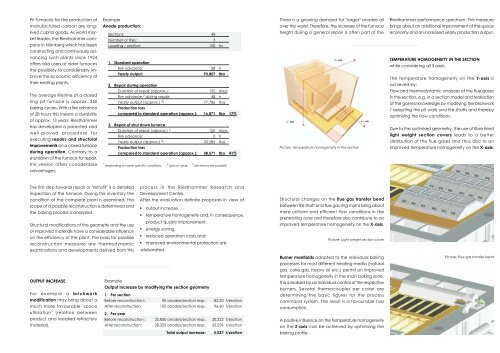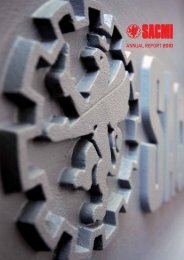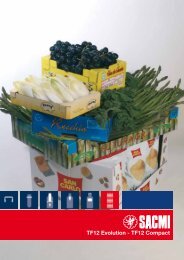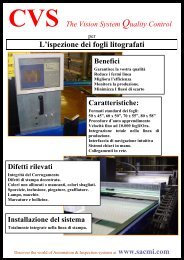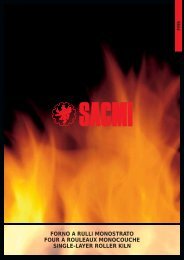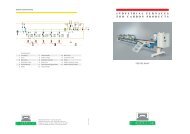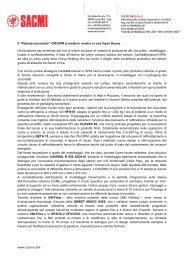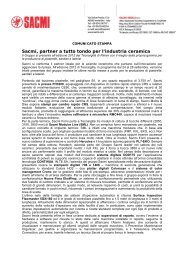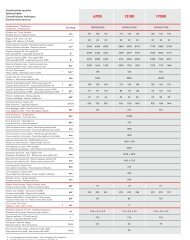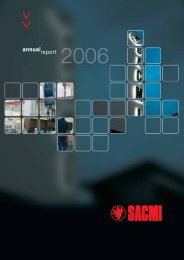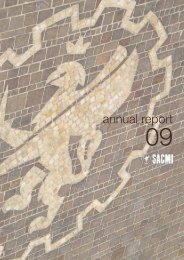Advanced Riedhammer Carbon Baking System - A Step ... - Sacmi
Advanced Riedhammer Carbon Baking System - A Step ... - Sacmi
Advanced Riedhammer Carbon Baking System - A Step ... - Sacmi
Create successful ePaper yourself
Turn your PDF publications into a flip-book with our unique Google optimized e-Paper software.
Pit furnaces for the production of<br />
Example<br />
There is a growing demand for "larger" anodes all<br />
<strong>Riedhammer</strong> performance spectrum. This measure<br />
manufactured carbon are long-<br />
Anode production:<br />
over the world. Therefore, the increase of the furnace<br />
brings about an additional improvement of the space<br />
lived capital goods. As world market<br />
leader, the <strong>Riedhammer</strong> company<br />
in Nürnberg which has been<br />
constructing and continuously ad-<br />
Sections: 48<br />
Number of fires: 3<br />
Loading / section: 100 ta<br />
height during a general repair is often part of the<br />
economy and an increased yearly production output.<br />
vancing such plants since 1924<br />
offers also users of older furnaces<br />
the possibility to considerably improve<br />
the economic efficiency of<br />
their existing plants.<br />
The average lifetime of a closed<br />
ring pit furnace is approx. 250<br />
baking cycles. With a fire advance<br />
of 28 hours this means a durability<br />
of approx. 13 years. <strong>Riedhammer</strong><br />
has developed a patented and<br />
well-proved procedure for<br />
executing repairs and structural<br />
improvements on a closed furnace<br />
during operation. Contrary to a<br />
shutdown of the furnace for repair,<br />
1. Standard operation<br />
Fire advance: 28 h<br />
Yearly output: 93,857 tba<br />
2. Repair during operation<br />
Duration of repair (approx.): 150 days<br />
Fire advance 2 during repair: 48 h<br />
Yearly output (approx.) 3 : 77,786 tba<br />
Production loss<br />
compared to standard operation (approx.): 16,071 tba 17%<br />
3. Repair of shut down furnace<br />
Duration of repair (approx.) 1 : 150 days<br />
Fire advance: 0 h<br />
Yearly output (approx.) 3 : 55,286 tba<br />
Production loss<br />
compared to standard operation (approx.): 38,571 tba 41%<br />
Picture: Temperature homogeneity in the section<br />
TEMPERATURE HOMOGENEITY IN THE SECTION<br />
while considering all 3 axes.<br />
The temperature homogeneity on the Y-axis is<br />
achieved by:<br />
Flow and thermodynamic analyses of the flue gases<br />
in the section, e.g. in a section model and realisation<br />
of the gained knowledge by modifying the brickwork<br />
/ adapting the pit walls and fire shafts and thereby<br />
optimising the flow conditions.<br />
Due to the optimised geometry, the use of fibre-lined<br />
light weight section covers leads to a better<br />
distribution of the flue gases and thus also to an<br />
improved temperature homogeneity on the X-axis.<br />
this version offers considerable<br />
1 depending on some specific conditions; 2 typical value; 3 deviations are possible<br />
advantages:<br />
The first step towards repair or "retrofit" is a detailed process in the <strong>Riedhammer</strong> Research and<br />
inspection of the furnace. During this inventory the Development Centre.<br />
condition of the complete plant is examined, the After the evaluation definite proposals in view of<br />
scope of a possible reconstruction is determined and<br />
§ output increase,<br />
the baking process is analysed.<br />
§ temperature homogeneity and, in consequence,<br />
product quality improvement,<br />
Structural modifications of the geometry and the use<br />
§ energy saving,<br />
of improved materials have a considerable influence<br />
on the efficiency of the plant. The basis for possible § reduced operation costs and<br />
reconstruction measures are thermodynamic § improved environmental protection are<br />
examinations and developments derived from this elaborated.<br />
OUTPUT INCREASE<br />
Example<br />
Output increase by modifying the section geometry<br />
For example a brickwork<br />
modification may bring about a<br />
1. Per section<br />
Before reconstruction: 90 anodes/section resp. 82.20 t/section<br />
much more favourable "space After reconstruction: 105 anodes/section resp. 96.60 t/section<br />
utilisation" (relation between<br />
product and installed refractory<br />
2. Per year<br />
Before reconstruction: 32,850 anodes/section resp. 30,222 t/section<br />
material).<br />
After reconstruction: 38,325 anodes/section resp. 35,259 t/section<br />
Total output increase: 5,037 t/section<br />
Structural changes on the flue gas transfer bend<br />
between fire shaft and flue gas ring mains bring about<br />
more uniform and efficient flow conditions in the<br />
preheating zone and therefore also contribute to an<br />
improved temperature homogeneity on the X-axis.<br />
Picture: Light-weight section cover<br />
Burner manifolds adapted to the individual baking<br />
processes for most different heating media (natural<br />
gas, coke gas, heavy oil etc.) permit an improved<br />
temperature homogeneity in the main baking zone.<br />
This is realised by an individual control of the respective<br />
burners. Several thermocouples per cover are<br />
determining the basic figures for the process<br />
command system. The result is a favourable fuel<br />
consumption.<br />
A positive influence on the temperature homogeneity<br />
on the Z-axis can be achieved by optimising the<br />
baking profile.<br />
Picture: Flue gas transfer bend


